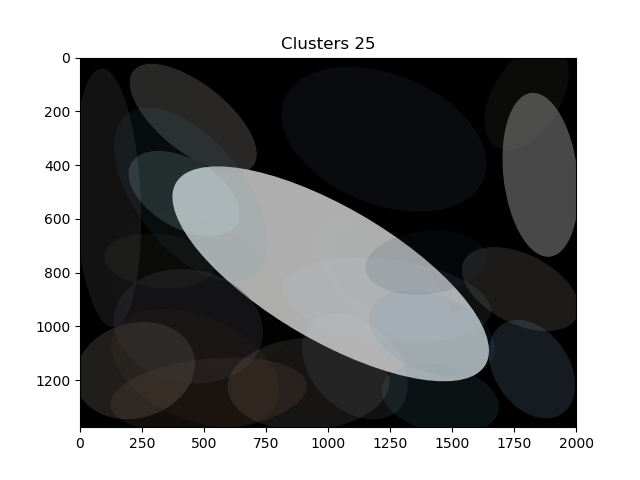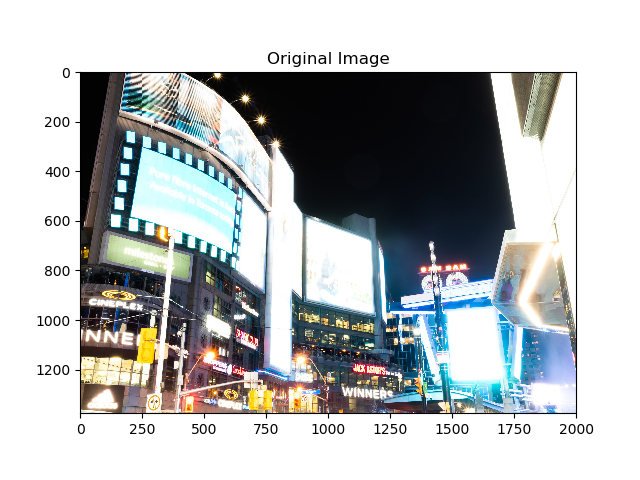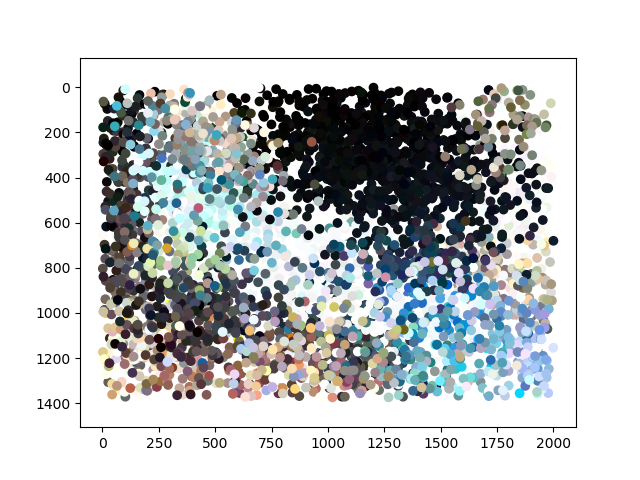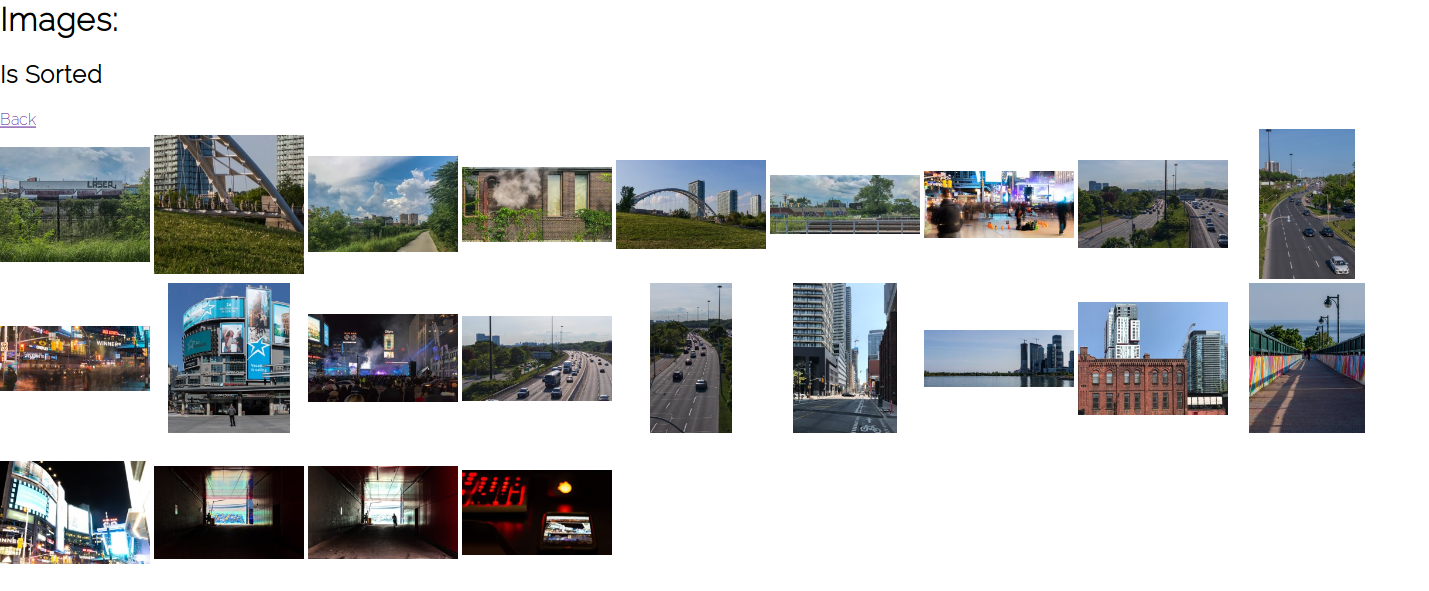Leitmotiv is an application meant to find reoccuring trends in photo collections. It also provided a good excuse to learn how variational Gaussian Mixture Models worked. The name is an alternate spelling of "leitmotif", which means a recurring pattern or motif.
This is still very much a work in progress so there isn't much formal documentation beyond this README. The code itself is heavily commented using Numpy-style docstrings.
At its core, leitmotiv is a effectively an image clustering system. It represents images as mixture models that are compared to one another using Jensen-Shannon divergences. The JS-divergence has some nice properties, such as being symmetric divergences, that makes it convenient to use in this application. The resulting set of pairwise distances is then partitioned using affinity propagation because it can work with distance matrices directly.
The application uses GMMs to represent images because these are generative models. That means you can pull new values from the modelled distribution. This has some potential applications when it comes to, for example, creating an "average image" of a set of images.
At a high-level, an image is a distribution of 5-dimension vectors, i.e.
(x,y,r,g,b). That encodes the fact that each spatial location has an
associated colour triplet. Representing this as a GMM is straightforward and
is a well-known technique. E.g., grab cuts uses it for modelling
foreground/background colour distributions. There are usually two complications
when working with images:
- You don't want to hard-code the resolution so you (somehow) have to be able to accept any image of any resolution.
- The number of clusters in the 5D features space are unknown.
Solving '1' is actually not too difficult. The key is to scale the feature vectors ahead of time so that they are zero-mean and unit variance. This might seem counter-intuitive but it has the advantage of making the feature vectors the same "size" regardless of how big the image image. The scaling itself is linear and invertible, so it's possible to always go back to the original feature space.
While it's possible to sample every pixel, the implementation doesn't do that. This would require quite a bit of time to find the GMM for even a modestly-sized image. Instead, the image is first blurred with a Gaussian kernel and then a fixed number of samples (implementation uses 5000) are taken. While there is a loss of detail, the overall image structure is still retained. The blurring also removes fine-scale details so that any sample is the actually the average of a local neighbourhood.
Solving '2' is a bit harder to deal with. In general, there is no "good" way to find the correct number of clusters and choosing this number is something that is done in hyperparameter tuning. However, some algorithms do not require knowing the number of clusters ahead of time. The variational Bayes GMM algorithm does just that: it can "learn" the number of clusters in the data set. Leitmotiv has its own implementation of this algorithm, which is from the same source as Scikit-Learn's (Pattern Recognition and Machine Learning by C. Bishop, 2006). This allows you to set the maximum number of clusters (the implementation default is 50) without having to worry about choosing the exact number.
When you train the GMM on an image, the output is a mixture model of a 5D distribution. For example, the GMM below
was obtained from the image below.
It's much easier to see the connection when you sample from the GMM to produce a new image, which is what's shown below.
Once you have a GMM for each image, you can compare images by looking at the
similarities between those GMMs. Similar images should have similar GMMs. The
way to compare GMMs is through divergences such as Kullbeck-Leibler or
Jensen-Shannon. Leitmotiv contains a Flask-based
web interface for exploring these relationships. Once the server is up and
running, it can be accessed at localhost:5000 in any browser.
Ranked Images
Images are ordered from most to least similar to the selected image (top-left corner). The default view shows images ordered by date captured. Selected an image will produce a page like the one below.
Image Clusters
Images are clustered using affinity propagation.
There is currently no link to this page; you have to access it by
localhost:5000/clusters.
The recommended way to run leitmotiv is through Docker as it takes care of managing all of the dependencies. It is possible to also build it manually using Conda environments, though this is more useful during development.
Running leitmotiv with docker is straightforward. First, build the container with:
$ sudo docker build -t leitmotiv .Images can be added into the leitmotiv database using the add-images.sh
script:
$ sudo ./scripts/add-images.sh /path/to/imagesThis usually requires passing a full path, e.g. /home/username/images since
Docker has to be able to mount the path in read-only mode. This script may take
a while to run as it is processing all of the images in the provided directory.
The leitmotiv webui is started by
$ sudo ./scripts/server.sh --startand stopped by
$ sudo ./scripts/server.sh --stopNote: sudo is used since this assumes that the current user is not part
of the 'docker' group. Please see the Docker daemon attack
surface
article for details.
Running leitmotiv is a bit more difficult because it requires creating a conda
environment followed by a separate pip install step. The reason for this is
that the numerical packages (such as numpy) have optimizations in the conda
builds that aren't necessarily in the wheels available on PyPI. The Docker
build does the exact same thing internally.
$ conda env create
$ conda activate leitmotiv
(leitmotiv) $ pip install . # or `pip install -e .` for editable builds
(leitmotiv) $ leitmotiv --help
Usage: leitmotiv [OPTIONS] COMMAND [ARGS]...
leitmotiv - Extract Trends from Image Collections
Options:
-c, --config PATH Path to application configuration file.
-d, --debug Enable all debugging output.
--help Show this message and exit.
Commands:
add-directory Add one or more directories into the library.
add-image Add either a single or multiple images into...
build-index Generate the image distance index.The source code is licensed under a BSD 3-Clause licence. Anything in the vendor folder may be subject to separate licence.




